|
NBRO stresses need to use safe construction methods:
More public awareness needed
By Dhaneshi Yatawara
|
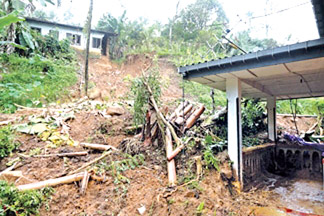
A typical example of risky construction
|
On the evening of October 22, Janaka Sampath of Hepanakanda in
Alawala in the Gampaha district returned home with his son Sandun 8, to
encounter the nightmare of his life. Hundreds of people were gathered
around his home which had taken away his 2 1/2 year old daughter,
forever. The land above their house, built on a risky slope, had slided
on to the house collapsing it and severely injuring his wife, Sandya
Rajapaksa and killing his baby daughter Achintha Divyangani.
The death of Achintha 2 1/2 alerted the risky situation the area
faced in being prone to natural disasters, although it was not in the
alerted list. Achintha's tragedy hilights the need for disaster
resilient habitats with strategies going beyond the already known
alerted areas. Several years ago, The National Building Research
Organization (NBRO) issued a list of ten districts identified as risky
areas prone to landslides. The districts are Ratnapura, Kegalle,
Kalutara, Galle, Matara, Hambantota, Nuwara Eliya, Badulla, Kandy and
Matale.
Hepanakanda in Alawala is located bordering Gampaha and Kegalle
districts, closer to the latter. Under the NBRO Kegalle is an alerted
area.
The NBRO states most of the houses in this area are insecurely
constructed on a nearly 40 degree slope. According to the guidelines for
construction in landslide prone areas issued by the NBRO, no
construction is recommended in a land with a slope of more than 31
degrees. Such lands will have a slope of more than 60%. Lands with 8% -
60% slope (5 degrees to 31 degrees slope angle) could have constructions
under strict guidelines. In Hepanakanda, where the recent disaster took
place more than 25 houses are built on steep slopes without any
landslide mitigating techniques.
Anyone constructing a building or a house in a landslide prone area
should do so in a way that would not trigger a landslide. The Disaster
Management Ministry has already issued circulars to the local
authorities of landslide prone districts to consult the Ministry before
approving constructions.
In Sri Lanka landslides are due to man-made reasons. Irresponsible
use of land led to many landslides in the past. If the weight of the
building does not suit the land, it could create a landslide.
Awareness
|
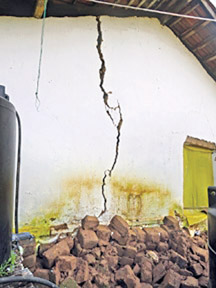
Cracks give the warning signals |
It has been an eye-opener for authorities to look into areas not
included in the alerted list. "Irrespective of specified areas we need
to look into all areas in the country to identify landslide prone
areas," said Director General of the NBRO Dr. Asiri Karunawardhana.
"People need to specifically understand the necessity of using safe
construction methods suitable to the particular land. It is for their
own safety and the safety of their property," Dr. Karunawardhana said.
"We are working closely with Sri Lankan universities engaged in studies
on the actual situation of the country and finding new technological
solutions," he added.
"We observe, the country's situation now is better than what it was.
People are more concerned about precautionary methods used in
constructions on risky lands," said Dr. Karunawardhana.
Is the landslide threat alert still on? Answering, the Head of
Landslide Studies and Services Division of the NBRO R.M.S. Bandara said
that it depends on as and when the situation arises. "It is difficult to
predict with this inter monsoon rains. The intensity of the rain largely
varies in this climate. So it is difficult to give a long term
prediction," Bandara said.
Bandara said, that considering the number of natural disasters the
country faces, buildings should be constructed in such a way to minimise
the damages of the disaster or mitigate the disaster. "There should be a
proper study of the nature of the disaster when constructing houses and
buildings in disaster prone areas," Bandara said. Making slight
deviations from standard construction methods could help to avert
damages to life and property, he said. It requires thinking out of the
box and needs the combined efforts of planners, construction regulatory
authorities and disaster management sector, he added.
Resilient cities
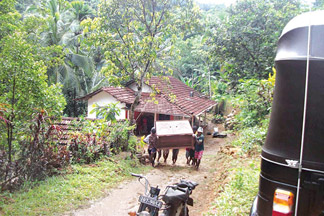 |
| Hepanakanda
villagers vacate their homes Pix: M. P. Kumara, Kotadeniyawa Gr.
Corr. |
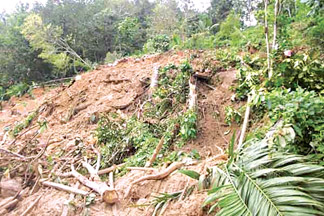 |
| In Hepanakanda
- the spot where the dwelling was |
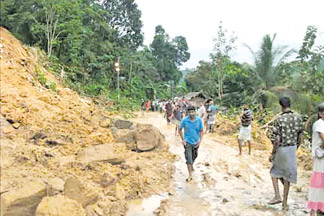 |
| The mud slide |
Is Sri Lanka concerned about resilient cities or any human
habitation? What is a resilient city? According to the United Nations
International Strategy for Disaster Risk Reduction (UNISDR) a resilient
city is characterised by its capacity to withstand or absorb the impact
of a hazard through resistance or adaptation, which enable it to
maintain certain basic functions and structures during a crisis, and
bounce back or recover from an event.
In such a situation disasters are minimised because the population
lives in homes and communities with organised services and
infrastructure that adhere to sensible building codes; without informal
settlements built on flood plains or steep slopes because no other land
is available. The local authorities and the population understand their
risks and develop a shared, local information base on disaster losses,
hazards and risks, including on who is exposed and who is vulnerable.
UNISDR founded the Making Cities Resilient campaign in May 2010 in
conjunction with partners including the United Nations Human Settlements
Program (UN-Habitat), United Cites and Local Governments, ICLEI-Local
Governments for Sustainability, CityNet, the European Commission
Community Humanitarian Office, the World Bank Global Facility for
Disaster Reduction and Recovery and several other academic institutions
and civil society groups.
NBRO has data and designs for construction plans to withstand floods,
cyclones and mitigate landslide possibilities. But now it will be
necessary for us to look into building plans that would withstand
possible earthquakes as well. A special seminar was held recently in Sri
Lanka, organised by the Disaster Management Ministry with the assistance
of the Japan International Corporation Agency (JAICA). The aim was to
share knowledge with one of the best disaster managing countries in the
world. Mitigating disaster is compulsory as damages of a disaster can
push back societies from poverty and beyond.
Earthquake
Addressing this special event, Terms of Reference of Knowledge and
Experience Seminar on Disaster Management, K.L.S.Sahabandu, Chairman of
the Sub Committee on Developing Building Guidelines for Earthquake
Resistant Designs, of the Disaster Management Centre said recent
geological studies have identified that the Indo - Australian Plate is
splitting at a distance of 500- 700 km away from the southwest coast of
Sri Lanka, creating a new plate margin. This may lead Sri Lanka to be
more vulnerable to earthquakes in the future than what is experienced
today.
Earthquake close to a city centre such as Colombo will have
disastrous consequences due to its present development and population.
Therefore we have understood the necessity to study the seismic effects
on Sri Lanka and take appropriate action to mitigate the same," he said.
It is not possible to prevent the occurrence of an earthquake since
it is a natural phenomenon. But damage can be minimised through
preparedness.
The DMC formed a subcommittee to develop building guidelines for
earthquake resistance designs.
The subcommittee investigates seismic activities around the country
and determines characteristics of earthquakes which may occur in the
future. The subcommittee also reviews the current design practice which
does not generally cater to seismic resistance and develop effective
design process to mitigate the effects of earthquake hazards in the
future. National policy on earthquake resistance designs shall be
prepared based on scientific evidence.
The Subcommittee to Develop Building Guidelines for Earthquake
Resistance Designs has also made proposals to conduct studies on
reviewing the seismic monitoring systems and propose improvement to the
system, developing seismic hazard maps including earthquake intensities,
acceleration coefficients, response spectrum, return periods,
development of a 3D sub-surface model that improves the susceptibility
of consequences against the possible earthquake in Sri Lanka,
development of national guidelines for seismic analysis and design of
engineered and non-engineered buildings in Sri Lanka.
The NBRO is carrying out a study in Colombo on how the buildings
would react to any tremor on the surface. " We need a vast collection of
data before arriving at a conclusion and setting up a guideline for
constructing buildings to resist earthquakes," said Head of Landslide
Studies and Services Division of the NBRO R.M.S. Bandara. The NBRO is
collecting data of more than 5000 spots where the land has been drilled
to various purposes. "We need to understand the soil profile variation
to understand how that particular land would react to an accelerated
vibration as well as the impact on the constructions on the surface,"
Bandara said.
Following the study the NBRO will establish a guideline to construct
buildings suitable to withstand an earthquake. |


